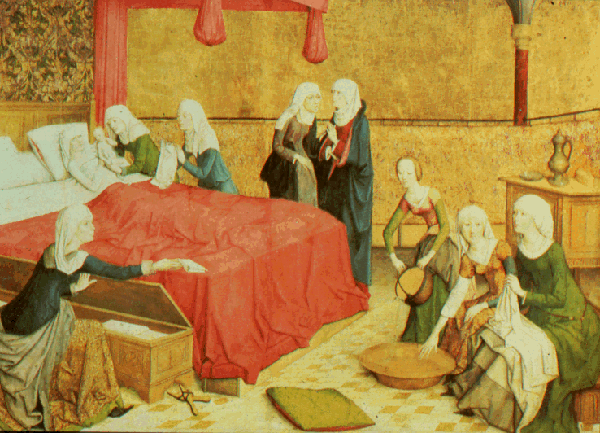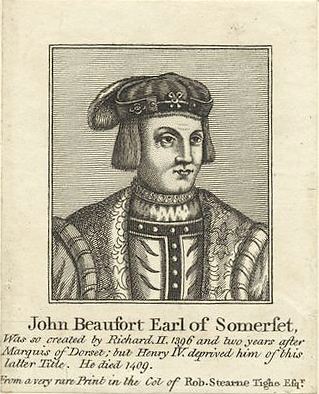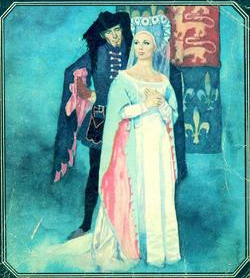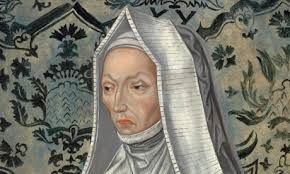
Here is the scene. The mother with her newly born child, her ladies, the air of relief and happiness. But presumably she is a faithful wife, and her delighted husband will soon be summoned to see his new offspring. No doubt he hopes for a son.
But what if she isn’t a faithful wife, and the sire of her baby isn’t her late husband. What’s more, the father is a royal prince?
The following article must be viewed against the 14th-century background of the Hundred Years War, the reigns of Edward III and Richard II, the plague and the convoluted private life of John of Gaunt, Duke of Lancaster . . . forebear of Margaret Beaufort, and therefore of Henry VII and the Tudors.
Just when did Gaunt (b. 6 March 1340 – d. 3 February 1399) become the lover of his children’s married governess, Katherine, Lady Swynford (b. 1349/50, d. 10 May 1403)? And was he first the lover of her sister, Philippa, who was married to Geoffrey Chaucer? In fact, were all the children born to Chaucer and Philippa actually Gaunt’s offspring? (See John Gardner, The Life and Times of Chaucer (New York: Alfred A. Knopf, INC., 1977), 158-162.)
I do not place much faith in this claim about Gaunt and Philippa, but if it were true, it raises an interesting point. Here is an extract from The Duchesses of Lancaster: an examination of English noblewomen’s exercise of power and influence during the fourteenth century, a thesis by Amanda Elizabeth Sanders.
“. . . Gaunt and Katherine confessed to having an affair during his marriage with Constance and that he was godfather to her eldest daughter with Hugh Swynford, which was seen as incest . . .”
Why was it considered incest? Because in the Fourth Lateran Council in 1215 it was recorded that anyone’s wife, or sexual partner, is related to her sisters in the first degree, which is incest. It was considered incest up to the fourth degrees of affinity. (See Harry Rothwell, English Historical Documents, 1189-1327,” in Love, Sex, and Marriage in the Middle Ages: A Sourcebook, ed. Conor McCarthy, (London: Routledge, 2004), 68-69.) Gaunt, being Philippa’s lover first and godfather to Katherine’s daughter Blanche Swynford, would have been considered to commit incest with Katherine, because she was within the degrees of affinity.
Well, I think I follow all that. My education stopped at GCE ‘O’ level in 1960, and I did not take history or religious education. A vital part of Henry VII’s ancestry was that his mother, Margaret Beaufort, could claim descent from John of Gaunt, and therefore Edward III . . . but it just might be that Gaunt had nothing whatsoever to do with John Beaufort’s conception, except to later claim fatherhood. (Note for those who do not know: Beaufort is the name granted to all of the children of Gaunt and Katherine Swynford.)
Disregarding any possible incest, the point of interest for me is that Gaunt and Katherine confessed to being lovers during his marriage to Constance of Castile. Call me Doubting Thomas, but I think it more likely they were lovers before that marriage, a conclusion I have reached while in pursuit of the all-important dates for the start of the affair with Katherine.
These matters are of great consequence to Ricardians (and Tudorites) because the parentage of Gaunt and Katherine’s eldest son, John Beaufort, 1st Earl of Somerset, can be called into question due to his actual date of birth not being known. The event is generally stated to be ‘circa 1373’, and anything ‘circa’ in mediaeval terms can stretch quite a way in either direction. Certainly to the middle of 1372, which is the date I believe.

To explain why, it is necessary to tell something of Katherine Swynford’s marriage to Sir Hugh Swynford (1340-September 1371), a fairly lowly knight of Kettlethorpe in Lincolnshire, whose only claim to distinction, apart from the identity of his wife, was being “small, stocky and known by his fellows as ‘the battling Saxon ram’!” He was a fierce and shrewd warrior, and clever battle tactician, with a beautiful but unfaithful wife from a lowly background in Hainault. But Katherine Swynford had been raised in the household of Queen Philippa, also from Hainault, and had the formal education and knowledge of court that made her ideal to become the governess of the queen’s grandchildren, Gaunt’s brood by his first duchess, Blanche of Lancaster.
In 1369, while Gaunt was away fighting the war on the continent, Katherine was called to Bolingbroke to spend Christmas with Blanche. But she arrived to find the duchess dying of the plague. Katherine took care of her, and managed to find a priest to administer the Last Rites. Katherine’s loving attentions were appreciated, and on his return to England, Gaunt invited her to come south to London to attend Blanche’s funeral. When she eventually went home to Kettlethorpe, he had rewarded her ‘for the care shown to the late Duchess and for the Lancastrian children after their mother’s death’. She had been granted her own blazon, consisting of three Catherine wheels, which Gaunt had designed, bestowed and registered himself. She also received, as a pension, ‘all issues from, and profits from his towns of Waddington and Wellingere to be paid yearly’.
Lavish rewards indeed! If I were Hugh, I’d be highly suspicious about the nature of the attentions Katherine had paid. And to whom! But there is no proof that anything had yet gone on between Katherine and the duke. Just a very strong hint, in my opinion.
There aren’t any known contemporary portraits of Gaunt and Katherine, so (to give a flavour) here is a rather romanticised view, taken from the cover of an edition of Anya Seton’s excellent novel, Katherine. Fiction maybe, but Katherine was very lovely, and Gaunt was indeed a royal prince.

Next, Hugh went to France to fight in a company led by Sir Robert Kindles, from whom Gaunt would take over command. In 1371 Hugh was seriously wounded and taken to Bordeaux in Gaunt’s train. The duke found him suitable lodgings and instructed his own personal physician, Brother William Appleton, to care for him. A certain Nirac de Bayanne, the duke’s servant (and Hugh’s enemy of old) is mentioned at this juncture, although he had actually entered the story a little earlier because he (and therefore Gaunt?) figured quite considerably in Swynford affairs.
From http://wc.rootsweb.ancestry.com/cgi-bin/igm.cgi?op=GET&db=ancestorsearch&id=I920
“ . . . May 1367 . . . when the registers note that John of Gaunt appointed his servitor, Nirac de Bayanne, as Steward over Kettlethorpe until Hugh could be sent home. They also record that he stood sponsor to Blanchette, Hugh and Katherine’s daughter born in May 1367 and ordered for her the silver and gilt cup as a baptismal gift . . .”
Hugh and Nirac did not get on at all, and I imagine Hugh resented the man’s presence on his land and in his house. Especially when Katherine was there and gave birth to their daughter.
Now we come forward to Bordeaux again, September 1371, and Hugh recovering from his wounds (or from dysentery, or both, according to opinion). Katherine arrived to be among the English ladies of Gaunt’s forthcoming second duchess, the Infanta Costanza (Constance) of Castile. Gaunt had sent that same Nirac de Bayanne to be Katherine’s escort, and was apparently highly annoyed when she went straight to tend her ailing husband.
The following has been gathered (not word for word) from http://wc.rootsweb.ancestry.com/cgi-bin/igm.cgi?op=GET&db=ancestorsearch&id=I920.
. . . Less than a week after Katherine’s arrival, Hugh was dead. His death surprised everyone as he had been making a good recovery. [It was thought he had been poisoned by the hate-filled Nirac de Bayanne, either from personal dislike or on the duke’s instruction.] Katherine seemed to have been genuinely shocked and upset by her husband’s passing. Aided by Brother William, she arranged for Hugh’s body to be returned to England and Kettlethorpe for burial. Unusually, she returned to court in Bordeaux, rather than accompany the body home. Hugh was buried, and faded into obscurity, leaving Katherine free to enter into a liaison with John [Gaunt] . . .
. . . Nirac was posthumously implicated in Hugh’s death. He is reputed to have confessed to poisoning Hugh, and on his deathbed repeatedly stated that neither John nor Katherine was aware of what he had done. (Hmmm. Maybe she didn’t, but I’d hazard Gaunt knew full well. Hugh was an inconvenience with a husband’s rights, and Katherine had just miffed the duke by putting her husband first. Were those conjugal rights being enjoyed? Might ducal jealousy have raised its head?) . . .
. . . It is known that John and Katherine disappeared for several weeks prior to his second marriage (which took place on 21st September 1371 near Bordeaux). She returned to England and was obviously pregnant because (in the summer of 1372?) she gave birth to John, later John Beaufort. It was assumed that John was Hugh’s posthumous child, but when Henry (My note: second Beaufort son) was born to [Gaunt] and Katherine, they acknowledged John as theirs . . .
Back to my narrative. So, September 1371 was a vital month in this story. Hugh probably died in about the first week, and Gaunt married Constance of Castile on 21st. Between the death and marriage, Gaunt and Katherine disappeared together . . . and they were not intent upon needlepoint, I’ll warrant. Katherine was not pretending to be a grieving widow, nor was Gaunt being much of a bridegroom. Given this conduct, I strongly suspect them of hanky-panky while poor old Hugh lingered.
When Gaunt returned to England not long after his wedding, he did not bring his new duchess with him. Going straight to the Savoy, he spent Christmas with his children by Blanche of Lancaster . . . and their widowed, pregnant governess was there too. If tongues did not wag into a thunderous racket, I would be absolutely amazed!
How intriguing is the whole scenario, because if it was thought Katherine’s child could be Hugh’s posthumous offspring, then presumably everyone in Bordeaux believed he had recovered enough to be capable of siring it! Maybe he would have survived had fate, or Nirac de Bayanne, not intervened.
So . . . was Hugh the real father of John Beaufort, 1st Earl of Somerset? He was still alive for the likely period of the earl’s conception. Might Katherine have warmed her husband’s bed and Gaunt’s during the same week? Should John Beaufort have actually been named John Swynford? His date of birth is unknown, and is given as ‘circa 1373’, which certainly could have encompassed the middle of 1372, which is nine months or so from September 1371.
And on top of all this, we have the interesting point mentioned at the very beginning. If Gaunt had been the lover of Philippa Chaucer before he tumbled into bed with Katherine, the latter relationship would have been regarded as incestuous, as well as adulterous. Their Beaufort children were subsequently legitimised, and specifically excluded from any claim to the throne, but I can’t imagine that, according to the then rules, they could be freed from the stigma of incest. Could the Pope have done that? I don’t know. (An aside: Presumably this means that Henry VIII’s activities with the Boleyn sisters was incestuous too?)
Oh, to get to the truth of it all, for the possibility exists that Margaret Beaufort, the scheming mother of the first Tudor king, might have only been the granddaughter of the obscure Kettlethorpe knight, Sir Hugh Swynford, not any offspring of Gaunt.
But there was more scandal, because when it came to blood descent, the man she took as her first husband, Edmund Tudor, Earl of Richmond, father of Henry VII, was most likely not a Tudor at all, but a Beaufort/Swynford by a son of the same John who had been conceived in Bordeaux in September 1371!
How could this be? Well, according to entirely different and equally salacious whispers, Edmund Tudor’s father wasn’t Owen Tudor (the supposed second husband of Queen Catherine of Valois, widow of Henry V) but was sired by one Edmund Beaufort, third son of the Bordeaux John Beaufort/Swynford. Catherine of Valois was widely rumoured to have had an affair with this Edmund Beaufort, who would not/could not marry her, but got her with child anyway. Catherine swiftly married Owen Tudor, maybe for love, maybe for protection. (Note: It cannot be proved that they actually did marry, but tradition has it they did.) The baby was born a Tudor, but naming him Edmund certainly fanned the rumours.
So, Margaret was Beauchamp on her mother’s side, but either Beaufort or Swynford on her father’s. Edmund Tudor was half Valois, and either Beaufort or half Swynford, but most likely not Tudor. Poor old Henry, all that playing upon his Welshness, and even naming his son and heir Arthur, when all the time there was most likely no proud descent from great Welsh heroes, both mythical and real, and certainly no link to Camelot. Or to Gaunt and Edward III. I would love to have seen the faces of Margaret and Henry had they discovered all this to be true.


I’m sorry, but the whole tale seems to be unsubstantiated if not libellous and if half the allegations used for the two Katherines were cast on the House of York one would cry havoc. “It is known that John and Katherine disappeared for weeks before his wedding” – known by whom? The novelist Anya Seton? As far as I am aware the real contemporary records on Katherine Swynford are scant to say the least, and none are quoted. Her whereabouts during Blanche’s death let alone John of Gaunt’s second wedding are not known (leaving only the sky as a limit to novelists the world over, with Anya Seton at one point in her book describing Katherine Swynford feeling as if she were treading a mine field… Oh yes, mine fields in the Middle Ages were aplenty, just like duke’s mistresses left behind facing a riot, etc.)
As for the main issue addressed in this post, I honestly doubt a royal duke would aknowledge any child born outside wedlock as his own were he not more than sure of the paternity and since Katherine already had two children by her first late husband, what exactly would have been the point for John of Gaunt to claim Swynford’s last son by Katherine as his own?
LikeLiked by 1 person
The illustration of Anya Seton’s book was merely that, an illustration. At no point do I claim that what she wrote was fact, nor do I rely upon her word. Do not use the mere mention of her book as proof that I have used it for reference. What I have written concerns rumour and speculation that existed at the time, which I rather thought I had made plain. Clearly not.
LikeLike
LOL wut
You have stated as fact:
That Hugh Swynford was known as “the battling Saxon ram”.
That Katherine Swynford was called to Bolingbroke to spend Christmas with Blanche. (In December 1369, at which time Blanche was dead.)
That Katherine arrived to find the Duchess dying of plague and managed to find a priest to administer the Last Rites.
That Hugh was seriously wounded in 1371 and went to Bordeaux in Gaunt’s train.
That “Hugh and Nirac did not get on at all”.
“Nirac was posthumously implicated in Hugh’s death”.
Nirac is reputed to have confessed to murdering Hugh
John and Katherine disappeared for several weeks prior to his marriage to Costanza.
ALL of this is the pure invention of Anya Seton. I love her novel “Katherine” but I know what is fact and what is fiction. It is not known how or where or exactly when Hugh Swynford died, only that he was dead by the time Katherine and Gaunt began their affair. There is no evidence he was murdered and it was never suspected he was murdered. Seton manufactured his murder because it added drama and tension to the book that it would have otherwised lacked.
As a novelist, she added other things as well, things that can’t be disproven but which there is no evidence for. One of them was Katherine visiting Blanche for Christmas, another was Katherine finding Blanche dying and getting a priest to administer Last Rites. But Seton, at least, has her dates right. She has Katherine visiting Blanche during Christmas 1367, not Christmas 1369, at which time Blanche was dead.
None of this was “rumor or speculation at the time.” All of it was invented by Anya Seton in the early 1950s. You very clearly did use her NOVEL for reference. Next you’ll recommend Philippa Gregory novels as textbooks.
LikeLike
Now I would like to apologize for the snotty tone of my post.
Truth is, I have had a crush on Henry VII ever since I saw the sexy actor play him in “The White Queen” and I’m mad that you’ve been mean about him.
LOL How embarrassing.
Regards
LikeLiked by 1 person
Okay, two corrections:
Anya Seton had Katherine visiting Blanche for Christmas in 1366, not 1367.
And the sexy actor playing Henry VII was in “The White Princess”, not the “The White Queen”.
Now I’ll see myself out.
LikeLiked by 1 person
Please quote the full reference and origin for the “rumour of the time” supporting the idea that contemporary records (which I am looking forward to being pointed to) reported that e.g. Katherine Swynford assisting Duchess Blanche during her agony, John of Gaunt and above mentioned Katherine Swynford disappearing for weeks before his second wedding, Hugh Swynford’s supposed recovery before his supposedly unexpected demise, etc. I would be happy to expand my knowledge.
LikeLike
The references are very widespread and easy to find, so I suggest you expand your knowledge by looking.
LikeLike
No, they are not and I have not seen a single shred of contemporary evidence now in two of your blog posts. There is no, zero, nada rumor at the time that John of Gaunt was getting it on with both sisters Roet. This was essentially a late 19th C and early 20th C rumor invented largely by people who were not historians to justify the then-current belief that everything Chaucer wrote was connected to his personal life, and he on more than one occasion seemed less than sanguine about romantic love and married life. In the 16th Century, Speght’s engraved title page I believe it was indicated that at that time, they didn’t even know who Philippa Chaucer was! This preoccupation prompted Chauerians to declare that Thomas, Elizabeth and possibly a third Chaucer child was the pawned off bastard offspring of John of Gaunt and Philippa Chaucer. Seems pretty unlikely and was not even a rumor in anyone’s mind in the 14th Century.
LikeLike
How marvellous it must be to know what was or was not in anyone’s mind in the 14th century. That’s quite a talent.
LikeLike
Start following your own suggestions before basing a post on a work of fiction. All contributors to this blog provide their references at the end of their articles or quote them in their article, you failed to do so because there are no “widespread references” to those ridiculous episodes you mention to be looking for.
However, I feel the serious audience of this blog may want to check Lucraft’s “Katherine Swynford”, an academic enlightening work that is sure to quote all real contemporary records on Richard III’s greatgrandmother (oh yes, he had Beaufort blood on his mother’s side too, so have a care before trashing it beyond its blatant illegittimacy)
LikeLike
I think you have misunderstood the confession. Being a godparent created an impediment to marriage between the godparent and the parent (also between the godparent and child). This means there were two impediments – spiritual affinity and the adultery.
So being a godparent also made the affair technical incest.
Since the purpose of the confession was to legitimate the marriage and the children, the absence of the confession of a third impediment that would have been created by a sexual relationship between Gaunt and the sister strongly suggests that no such relationship existed.
LikeLike
You may be right, David. I’m no expert on such things and was merely quoting the source, Gardner, who considers the matter at some length. I take the Philippa story with a pinch of salt, and have said so in the article.
LikeLike
I had forgotten to ask – what is the source for the contemporary rumours that Owen Tudor was not the father of Edmund?
LikeLike
This is mentioned in Jones’ ODNB article, as cited in “Royal Marriage Secrets”.
LikeLike
I found all of the following on the internet. Looks like SCIENCE has started the ball rolling as they say, concerning paternity questions:
“The Beaufort kids were named for the Beaufort property belonging to John of Gaunt..They were all born at Kettlethorpe Manor in Leicestershire which is where Katherine de Roet Swynford lived with her 1st husband Sir Hugh Swynford and stayed on there after he died as she inherited the property as his widow. The eldest son John Beaufort was discovered, in 2017, to be a posthumous child of Sir Hugh Swynford when his Somerset descendants’ DNA was compared to Richard III’s…a known descendant of John of Gaunt.”
The above was quoted by someone in a forum. You may do an internet search to find any news articles. Here are a few I found:
https://www.theguardian.com/uk-news/2014/dec/02/king-richard-iii-dna-cousins-queen-ancestry
https://www.theguardian.com/uk-news/2015/mar/25/richard-iii-dna-tests-uncover-evidence-of-further-royal-scandal
https://catholicherald.co.uk/commentandblogs/2014/12/04/the-mystery-of-richard-iiis-dna-are-the-royal-family-who-we-think-they-are/
LikeLike
That false paternity event, or perhaps more than one, who knows? could have happened any time during the hundreds of years since John Beaufort was born. It does not prove that he was the son of Hugh Swynford.
LikeLike
Thanks for the blog post! Thoroughly enjoyed it! 🙂
LikeLike
It’s unlikely that John Beaufort was conceived in double adultery, read https://groups.google.com/d/msg/soc.genealogy.medieval/mK-N3FiT_Ag/ORAlRC8mAAAJ. I find it more likely that the non-paternity event was with Richard of Conisburgh.
LikeLike
Thank you for the link! I’ll take a look at it..
LikeLike